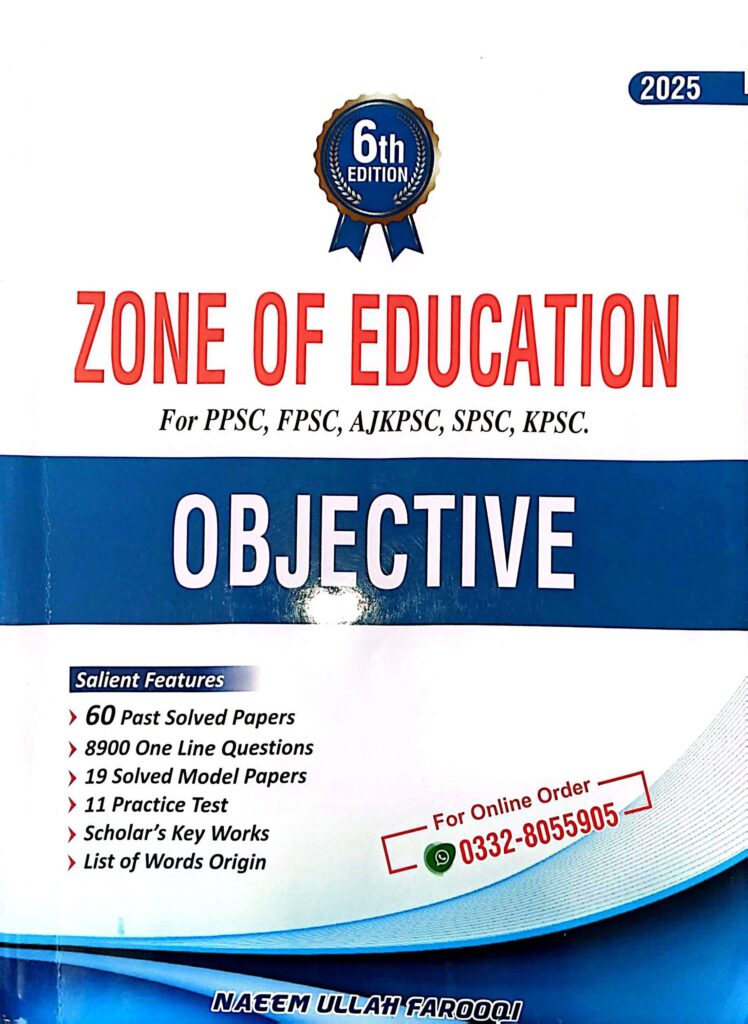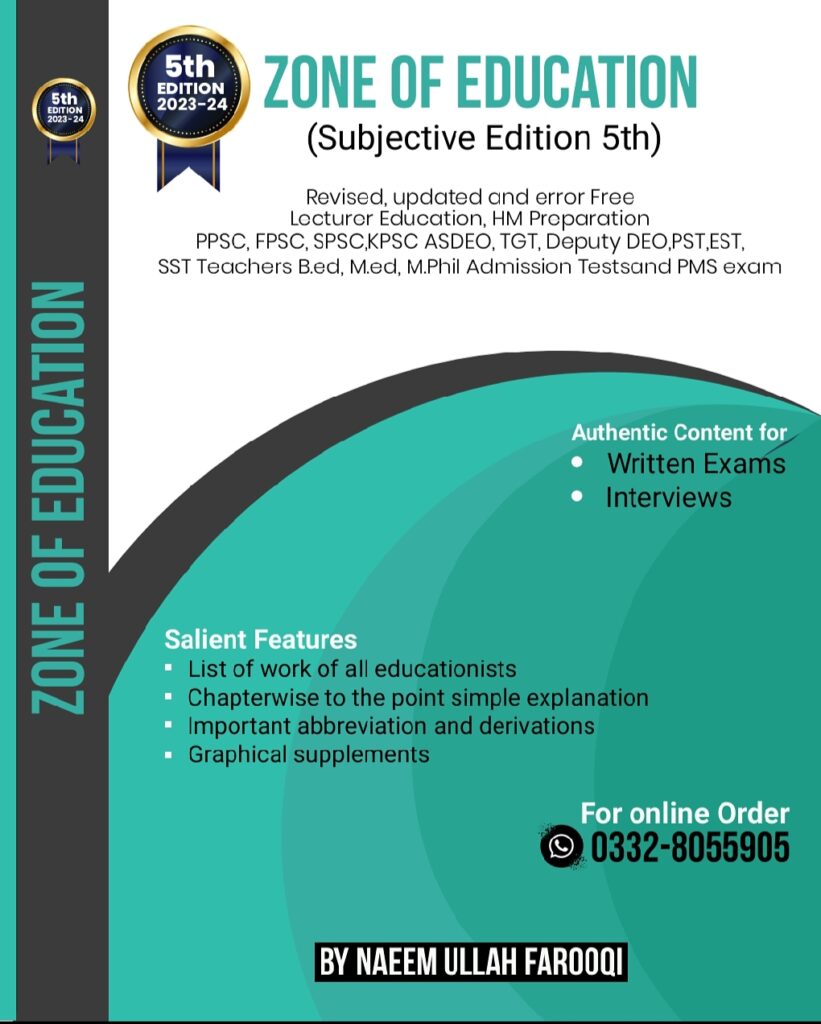Psychology
.1. Students’ motivation is the purpose of:
o A. Basic evaluation
o B. Overall evaluation
o C. Optional evaluation
o D. Individual evaluation
o Ans: (A) Basic evaluation
2. Who introduced the term “mental tests”?
o A. Jean Piaget
o B. Cattell
o C. Rousseau
o D. Thorndike
o Ans: (B) Cattell
3. The famous educational psychologist Alfred Binet was:
o A. French
o B. German
o C. Russian
o D. American
o Ans: (A) French
4. The famous educational psychologist Terman was:
o A. French
o B. German
o C. Russian
o D. American
o Ans: (D) American
5. The first Binet-Simon test appeared with revisions in 1908 and:
o A. 1911
o B. 1912
o C. 1913
o D. 1914
o Ans: (A) 1911
6. During World War I, the testing of the intelligence of individuals began in:
o A. Experience
o B. As a whole
o C. Combinations
o D. Groups
o Ans: (D) Groups
7. Which test represents the tests of abstract intelligence?
o A. Language
o B. Percentage
o C. Leadership
o D. Measurement
o Ans: (A) Language
8. Emotional adjustment of students is effective in:
o A. Personality development
o B. Classroom teaching
o C. Discipline
o D. All of the above
o Ans: (D) All of the above
9. Who developed the interaction analysis category system in education for increasing teacher effectiveness?
o A. Flander
o B. Rayon
o C. Amidon and Simon
o D. Richard Over
o Ans: (A) Flander
10. The theory of moral development has been proposed by:
o A. Lawrence Kohlberg
o B. Erik Fromm
o C. Daniel Coleman
o D. Benjamin Bloom
o Ans: (A) Lawrence Kohlberg
11. The Father of Psychoanalysis is:
o A. Erik H. Erikson
o B. Jean Piaget
o C. Jerome S. Bruner
o D. Sigmund Freud
o Ans: (D) Sigmund Freud
12. The proponent of the Cognitive Theory of teaching is:
o A. N. L. Gagne
o B. Einstein
o C. B. F. Skinner
o D. McDonald
o Ans: (A) N. L. Gagne
13. Dogar’s Testmaster is related to:
o A. Academic exams
o B. Competitive exams
o C. Skill development
o D. Preparation for life
o Ans: (B) Competitive exams
14. John Dewey’s best definition of education was:
o A. Education as a product
o B. Recapitulation
o C. Acquisition of knowledge
o D. Preparation for life
o Ans: (B) Recapitulation
15. It is easier to predict success in an occupation on the basis of:
o A. Failure
o B. Temperament
o C. Interest
o D. Adjustment
o Ans: (A) Failure
16. Frustration of motives causes:
o A. Inferiority
o B. Anxiety
o C. Inefficiency
o D. Behavior disorder
o Ans: (D) Behavior disorder
17. Motives arouse behavior and direct it towards:
o A. An appropriate goal
o B. Inference
o C. Prediction
o D. None of the rest
o Ans: (A) An appropriate goal
18. Learning that involves motor organs is called:
o A. Sensory learning
o B. Motor learning
o C. Verbal learning
o D. Sensory-motor learning
o Ans: (B) Motor learning
19. The problem child is generally one who has:
o A. An unsolved problem
o B. A poor heredity
o C. A poor home environment
o D. A younger brother or sister
o Ans: (A) An unsolved problem
20. Four conditions that must exist in a classroom before any motivational strategies can be successful:
o A. The teacher must be a supportive person
o B. The classroom must be disorganized
o C. The tasks set for students must not be authentic
o D. Constant disruption in class
o Ans: (A) The teacher must be a supportive person
21. Motivation is the release of tension towards a goal by proceeding:
o A. Pride
o B. Tension
o C. Knowledge
o D. Power
o Ans: (B) Tension
22. Nature and Nurture refer to:
o A. Internal and External Environment
o B. Temperament and character
o C. Physical features and temperament
o D. Heredity and Environment
o Ans: (D) Heredity and Environment
23. Motivation should be followed by:
o A. Reward
o B. Reproof
o C. Knowledge of result
o D. Incentive
o Ans: . Reward
24. Motivation should be followed by:
o A. Reward
o B. Reproof
o C. Knowledge of result
o D. Incentive
o Ans: (A) Reward
25. Teachers and parents give more importance to the development of intelligence among students as it facilitates:
o A. Academic achievement and social respectability
o B. Less risk-taking behavior
o C. Dependence behavior
o D. Obedient behavior
o Ans: (A) Academic achievement and social respectability
26. The child’s increasing skill at using his muscles is due chiefly to:
o A. Maturation
o B. Learning
o C. Pushing by parents
o D. None of these
o Ans: (B) Learning
27. One of psychology’s major contributions in education lies in:
o A. Providing a scientific foundation for teaching
o B. Defining the goals of teaching
o C. Identifying successful educational procedures
o D. Comparing the relative effectiveness of various teaching procedures
o Ans: (D) Comparing the relative effectiveness of various teaching procedures
28. The term “Mental Hygiene” was introduced by:
o A. C.L. Pierce
o B. C.W. Bears
o C. William James
o D. James D. Page
o Ans: (B) C.W. Bears
29. Interview is basically a method of:
o A. Selection
o B. Personality assessment
o C. Personality make-up
o D. Attitude assessment
o Ans: (B) Personality assessment
30. The nature of personality can be defined as:
o A. Emotional
o B. Motivational
o C. Attitudinal
o D. Psycho-physical
o Ans: (D) Psycho-physical
31. ‘Case history method’ is a part of:
o A. Behavioral technique
o B. Study technique
o C. Diagnostic technique
o D. Gamma-technique
o Ans: (A) Behavioral technique
32. Who was the first psychologist to make the personality inventory?
o A. Freeman
o B. F. Galton
o C. Frankman
o D. Tolman
o Ans: (B) F. Galton
33. The concept of collective unconscious was promoted by:
o A. Freud
o B. Jung
o C. Adler
o D. Alter
o Ans: (B) Jung
34. Who constructed the personality structure: Id, Ego, and Superego?
o A. Eysenck
o B. Freud
o C. Crystal
o D. Krebs
o Ans: (B) Freud
35. Lack of confidence and emotional security in children is mostly caused by:
o A. Over affection
o B. Under affection
o C. Rejection
o D. Ill-treatment
o Ans: (C) Rejection
JOIN ZONE OF EDUCATIONPK!
Discover the most comprehensive and reliable pedagogy resources in Pakistan, curated for competitive exam success. Our content covers all competitive exam MCQs, including PPSC, FPSC, AJKPSC, SPSC, and more. Designed to empower learners with top-notch material and insights, trust us for your preparation journey!


